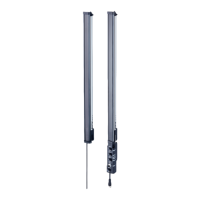E1 E2 E3 E4
E1/E10
E9 E10
1
E1 E2
E1/E10
E9 E10
1
E8E7
Figure 69: Assignment of detected edges
1
Middle
If, in the application, it is possible for a different number of edges to exist for temporal
re
asons, e.g. for partially-transparent objects with patterns or changing contrasts or
particularly for objects with the possibility of disappearance (e.g. band crack), a specific
edge may contain another number depending on the time.
The edge will therefore disappear under the original assignment and can no longer be
traced. In this constellation, the “With search field” device mode can help to implement
continuous edge tracking.
E1 E2
E1/E10
E9 E10
1
E1/E10
E9 E10
1
E2E1
Figure 70: Disappearance of edges (e.g. due to band crack)
1
Middle
In the “With search fields” device mode, the user specifies the MLG-2 expected areas
(sear
ch field) for the edges to be tracked. For the specific edge he/she numbers, the
user defines a spatial area within the measuring range (search field for edge Ex) in
which this edge Ex is expected.
An edge detected in this area by the MLG-2 is assigned as edge Ex. If desired, the user
can label the outer edge as desired. If two edges are detected in this range, the sensor
does not detect this as en edge.
E3 E4 E9 E10
E
5 E6E4E3E1 E2
E1 E2
Figure 71: Search fields around edges
If the number of ed
ge changes, e.g. with a band crack, assignment of other edges
remains and these can continue to be tracked.
CONFIGURATION WITH SOPAS 11
8025190/2020-01-13 | SICK O P E R A T I N G I N S T R U C T I O N S | MLG-2 WebChecker
99
Subject to change without notice

